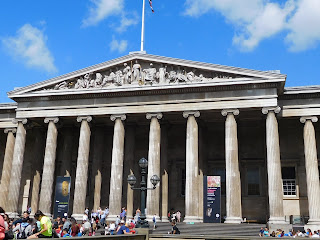Our wedding anniversary this week: our fifteenth. Usually, we would have had a quiet lunch in a country restaurant to mark the event, but I thought that my husband would enjoy the view from the restaurant at Tate Modern - and the food. I booked a table and tickets for the Barbara Hepworth exhibition, on-line.
We were enjoying a bit of sight -seeing in this unfamiliar part of London. This is the house where Sir Christopher Wren lived while St Paul's was being built just across the river.
Over to the East, the skyline is both distinctive and improbable. What can it be like to work in some of these buildings?
With plenty of time to spare, I went to the ticket desk to pick up the tickets for the exhibition before we went up for lunch.
"Ah, " said the young man. "Just one problem. The Barbara Hepworth exhibition is at the other Tate Gallery - Tate Britain."
I guess I was just lucky it was not the one in St Ives....
Over lunch we agreed that the boat trip down the river would be fun, and so it proved to be. It was a wonderfully comfortable boat. We passed right alongside the Palace of Westminster, arriving at the other Tate in twenty minutes.
The exhibition was well worth a visit too: streamlined shapes with complex voids and cool textures.
We were enjoying a bit of sight -seeing in this unfamiliar part of London. This is the house where Sir Christopher Wren lived while St Paul's was being built just across the river.
Over to the East, the skyline is both distinctive and improbable. What can it be like to work in some of these buildings?
With plenty of time to spare, I went to the ticket desk to pick up the tickets for the exhibition before we went up for lunch.
"Ah, " said the young man. "Just one problem. The Barbara Hepworth exhibition is at the other Tate Gallery - Tate Britain."
I guess I was just lucky it was not the one in St Ives....
 |
| Dessert -- note Millennium Bridge below. |
Over lunch we agreed that the boat trip down the river would be fun, and so it proved to be. It was a wonderfully comfortable boat. We passed right alongside the Palace of Westminster, arriving at the other Tate in twenty minutes.
The exhibition was well worth a visit too: streamlined shapes with complex voids and cool textures.































.JPG)